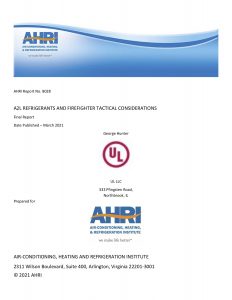
AHRI releases study on fire safety and A2L refrigerants
March 19, 2021 | By HPAC Magazine
The study involved UL and the Firefighter Safety Research Institute (FSRI) testing refrigerants in real-world situations.

The U.S.-based Air Conditioning, Heating and Refrigeration Institute (AHRI) has released a report that examines fire safety issues related to mildly-flammable A2L refrigerants.
The study was undertaken in cooperation with UL and the Firefighter Safety Research Institute (FSRI) in which refrigerants classified by ASHRAE as A2L (lower flammability) were tested and compared with A1 (no flame-spread) refrigerants in real-world situations.
The fire service requested that data be developed to identify hazards to the fire service personnel when responding to fire events in occupancies with the new refrigerants. The results will lead to the development of training programs for firefighting personnel when responding to fires in occupancies with both new (A2L) and existing (A1) refrigerants.
The project included scenarios designed by fire service professionals. Specifically, they identified the following areas where performance data of A2L refrigerants would assist them in their tactical considerations.
- Comparison and contribution of A1 and A2L refrigerants in a fire relative to heat and gases generated;
- Potential for flash fire, deflagration, or explosion hazards in residential and commercial applications; and
- Influence on fire dynamics from refrigerant leakage during fire service suppression and overhaul activities.
Five fire scenarios were designed for study, in summary the refrigerant reactions delivered similar results in most scenarios. Both A1 and A2L refrigerants generated hydrogen fluoride (HF) gas in quantities considered hazardous without PPE, in most scenarios there was not a significant relative difference in HF gas generation between the A1 and A2L refrigerants used in the investigation.
In the one scenario examining the effect of igniting a large quantity of refrigerant pooled at the floor level from a slow leak, the levels of HF gas from the A1 refrigerant were observed to be generated near the ignition source and developed at a much slower pace than the A2L refrigerant. The levels of HF from the A2L refrigerant were significantly higher and faster developing due to spread of the fire to the pooled layer in the room.
For a complete look at study including refrigerants used visit:




